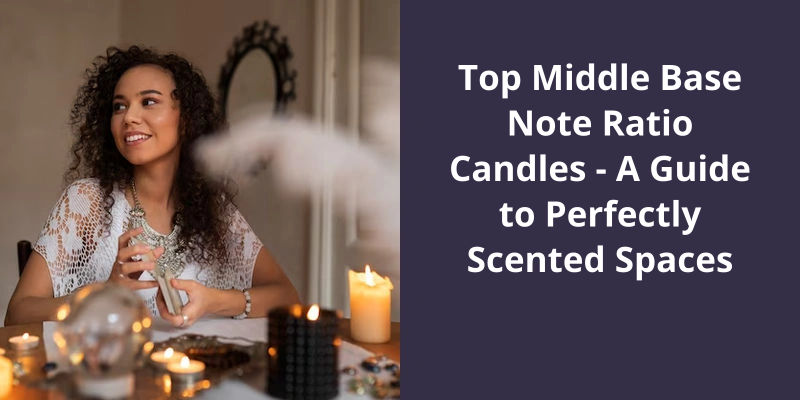The top, middle, and base notes are integral components of a candle’s scent, each contributing distinct qualities to the overall aroma. The top notes provide the first scent impression, usually comprising around 10-30% of the total fragrance. The middle or heart notes define the core of the scent, representing about 30-50% of the blend. Finally, base notes underpin the fragrance, adding depth and solidifying the scent – they typically make up about 20-50% of the mixture. This ratio may vary depending on specific candle recipes or the desired final aroma, but typically, the heart notes make up the biggest part while top notes are the least present. It’s important to achieve a harmonious balance between all notes to create a well-rounded, appealing scent.

What Are the Base Notes for Candle Making?
Candle making is an ancient art that’s been practiced for centuries. One of the most important things to consider when creating a candle is the scent that it will emit when lit. The scent of a candle can be made up of many different notes, with base notes being one of the most important.
There are many different base notes commonly used in candle making, such as vanilla, patchouli, musk, amber, balms, moss, and woody fragrances. These notes are chosen for their ability to create a long-lasting scent that will fill a room and create a calming and relaxing ambiance. Base notes are often combined with top notes and middle notes to create a complex and layered fragrance that will appeal to a wide range of people.
When working with base notes, it’s important to remember that they’ve the largest molecules which means they evaporate slowly. This makes them perfect for creating a long-lasting scent that lingers in the air for hours. Base notes are typically added to the candle wax during the melting process so that they’re evenly distributed throughout the wax and can be released slowly as the candle burns.
Essential Oils vs. Fragrance Oils in Candle Making
- Essential oils are natural plant extracts obtained through distillation or cold pressing.
- Fragrance oils are synthetic or artificial oils created in a laboratory.
- Essential oils offer therapeutic benefits and are often used for aromatherapy.
- Fragrance oils offer a wide variety of scents and are often less expensive than essential oils.
- When using essential oils in candle making, it’s important to check for any safety concerns or precautions.
- When using fragrance oils in candle making, it’s important to choose high-quality oils and follow recommended usage rates.
Understanding the concept of fragrance notes is an essential step towards choosing the perfect scent for one’s personality and occasions. As we’ve learned, the top, middle, and base notes work together to create a unique blend of aromas that evolve over time. In the next section, we will delve deeper into the different types of perfume and how they suit different preferences and settings.
What Are Base Middle and Top Notes?
In fragrance, the base notes are what lingers the longest and is what you smell even after hours of wear. They’re usually made up of heavier, richer ingredients like woods and resins. Examples of base notes that are commonly used in perfumery include patchouli, musk, vanilla, sandalwood, and amber.
Middle notes play a crucial role in a fragrance because it essentially provides the backbone or structure of a scent. This is where you may smell floral or herbal notes like lavender, rose, or jasmine. The middle notes last for several hours and are often responsible for the lasting impression that a perfume leaves.
Lastly, top notes are usually the first thing that you smell in a perfume. They’re light, refreshing, and typically made up of ingredients like citrus, fruit, and herbs. Top notes will evaporate rather quickly once applied, but they set the tone for the rest of the fragrance experience. In fact, because they’re so fleeting, it’s common to smell the top notes again and again as a way to refresh the scent throughout the day.
Perfumers use these notes in different ratios to create unique and complex fragrances. When looking for the perfect scent, it’s important to consider not only what you like the smell of, but also how it will develop and change over time. With a little bit of research and some experimentation, youre sure to find a fragrance that perfectly suits your individual style and personality.
Source: Top, Middle and Base Notes, What … – The Society of Scent
When it comes to creating your own essential oil blends, it’s important to understand the ratios of top, middle, and base notes. Following the 30:50:20 ratio can help ensure a balanced and harmonious scent. However, it’s also important to give your blends time to fully develop and harmonize before use. Read on to learn more about essential oil blending and how to create your own unique scents.
What Is the Ratio of Top Middle and Base Notes for Essential Oils?
Essential oils are powerful plant extracts that have gained popularity for their therapeutic and aromatic properties. These oils are derived from various parts of plants such as leaves, flowers, fruits, roots, and bark. One of the key aspects of using essential oils is mixing them in the right proportions to create a balanced and pleasant aroma. This is where the ratio of top, middle, and base notes comes in.
The 30:50:20 ratio is a widely accepted rule of thumb when it comes to blending essential oils. This ratio divides the scent notes into three categories – top, middle, and base notes. Top notes are usually the first aromas that are detected when essential oils are opened and are characterized as bright, refreshing, and uplifting. Examples of top notes include lemon, bergamot, and peppermint.
Middle notes are considered the heart of the fragrance and are known for their balance and harmony. These notes are usually detected a few minutes after the top notes and can last for several hours. Examples of middle notes include lavender, rosemary, and geranium.
A base note is the foundation or anchor of the fragrance, providing depth and longevity. Examples of base notes include frankincense, myrrh, and sandalwood.
This formula ensures that the fragrance has a good balance of top, middle, and base notes. Failing to comply with this ratio can result in a fragrance that’s either too overpowering, too weak, or just unbalanced.
After blending the essential oils, you should let the blend rest for a day or two to allow the oils to harmonize and mature. During this time, the scent notes interact with each other, and the fragrance becomes more pronounced and well-rounded. Once the blend has rested, it’s important to label it clearly to avoid confusion.
Blending essential oils is an art that requires careful consideration of the top, middle, and base notes. The 30:50:20 ratio provides a guideline to help you create a balanced and pleasant fragrance. With these tips, you can create your own unique blend that suits your preferences and needs.
Conclusion
In conclusion, the art of candle making is a delicate balance of choosing the right fragrance notes and the correct ratio in which they’re blended. The role of each note, whether top, middle or base, is crucial in creating the desired experience for the consumer. With the appropriate ratio of fragrance notes, candles can transport individuals to different places, evoke emotions, and create an ambiance.





